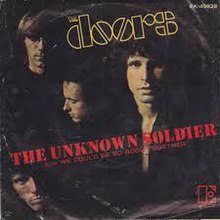The Unknown Soldier (song)
| "The Unknown Soldier" | ||||
|---|---|---|---|---|
 | ||||
| Single by the Doors | ||||
| from the album Waiting for the Sun | ||||
| B-side | "We Could Be So Good Together" | |||
| Released | March 1968 | |||
| Recorded | February 1968 | |||
| Studio | TTG Studios, Hollywood, California | |||
| Genre | Rock | |||
| Length | 3:22 | |||
| Label | Elektra | |||
| Songwriter(s) | The Doors | |||
| Producer(s) | Paul A. Rothchild | |||
| The Doors singles chronology | ||||
| ||||
"The Unknown Soldier" is the first single from the Doors' 1968 album Waiting for the Sun and released in March of that year by Elektra Records. An accompanying 16mm publicity film for the song featuring the band was directed and produced by Edward Dephoure and Mark Abramson. The song became the band's fourth Top 40 hit in the US, peaking at number 39 on the Billboard Hot 100, and remained upon the Billboard Hot 100 list for eight weeks.
Lyrics[]

"The Unknown Soldier" was perceived as Jim Morrison's reaction to the Vietnam War and the way that conflict was portrayed in American media at the time.[1] According to author Richie Weidman, Morrison was inspired to write the lyrics after visiting the Tomb of the Unknown Soldier, at the Arlington National Cemetery, on November 25, 1967; the same day in which the band performed at the Hilton Hotel, International Ballroom.[2]
The song features lines such as "Breakfast where the news is read/ Television children fed/ Unborn living, living dead/ Bullets strike the helmet's head", which concerned the way news of the war was being presented in the living rooms of ordinary people.[1] The track ends with sounds of crowds cheering and bells tolling, representing an ecstatic celebration of a war being over.[3]
Release and reception[]
Release and charts[]
The released single was edited in which a different gunshot sound was used and does not include the cheering crowds nor the tolling bells at the end. Reportedly, producer Paul Rothchild was so particular about how the song came out that it ultimately took over 130 takes to finish.[4] Upon completion, the song became the band's fourth Top 40 hit in the US, peaking at number 39 on the Billboard Hot 100, and enjoying an 8-week appearance on the Billboard Hot 100 list overall.[5] "We Could Be So Good Together" served as the B-side. However, the lyrics were controversial at the time and many radio stations refused to play it.[6]
| Chart (1968) | Peak position |
Date |
|---|---|---|
| US Billboard Hot 100[7] | 39 | May 1968 |
Reception[]
Upon its release, "The Unknown Soldier" received positive responses by critics. Matthew Greenwald of AllMusic praised both the song's lyrics and music;[3] he commented the song, verse by verse:
It opens with an eerie organ intro before moving into a jazzy first verse ... A brilliant and dramatic middle section is actually a studio-recreated firing squad, complete with shots. The second verse is a slightly harder-rocking version of the first. The song then erupts into a climatic, extended coda.[3]
The New Musical Express identified the song as "the standout" of Waiting for the Sun's side one.[8] Critic Richie Unterberger declared "The Unknown Soldier" as one of the "first-rate tunes" of the album. He described it as "spooky" and "uncompromisingly forceful as anything the band did."[9] Billboard described the single as "one of the most unusual and intriguing disks of the week in both arrangement and material" that "should prove a top chart item."[10]
See also[]
References[]
- ^ Jump up to: a b Whitaker, Sterling (May 20, 2013). "The Doors, 'Unknown Soldier' – Songs About Soldiers". Ultimate Classic Rock. Retrieved July 10, 2020.
- ^ Weidman, Rich (2011). The Doors FAQ: All That's Left to Know About the Kings of Acid Rock. Rowman & Littlefield. p. 194. ISBN 978-1617131141.
- ^ Jump up to: a b c Greenwald, Matthew. "The Doors: 'The Unknown Soldier' – Review". AllMusic. Retrieved February 26, 2021.
- ^ Hopkins, Jerry; Sugerman, Danny (1980). No One Here Gets Out Alive. p. 179. ISBN 978-0-446-60228-0.
- ^ "The Hot 100 – May 18, 1968". Billboard. Retrieved November 4, 2016.
- ^ Simpson, Dave (June 17, 2015). "The Doors: 10 of the Best". The Guardian. Retrieved August 5, 2020.
- ^ "The Doors Chart History: Hot 100". Billboard.com. 2019. Archived from the original on May 7, 2018. Retrieved August 23, 2019.
- ^ "Waiting for the Sun Review". New Musical Express. Retrieved February 21, 2021 – via Thedoors.com.
- ^ Unterberger, Richie. "The Doors: Waiting for the Sun". AllMusic. Retrieved February 21, 2021.
- ^ "Spotlight Singles" (PDF). Billboard. March 23, 1968. p. 74. Retrieved February 23, 2021.
- The Doors songs
- Anti-war songs
- Songs of the Vietnam War
- 1968 songs
- 1968 singles
- Songs written by John Densmore
- Songs written by Robby Krieger
- Songs written by Ray Manzarek
- Songs written by Jim Morrison
- Song recordings produced by Paul A. Rothchild
- Elektra Records singles